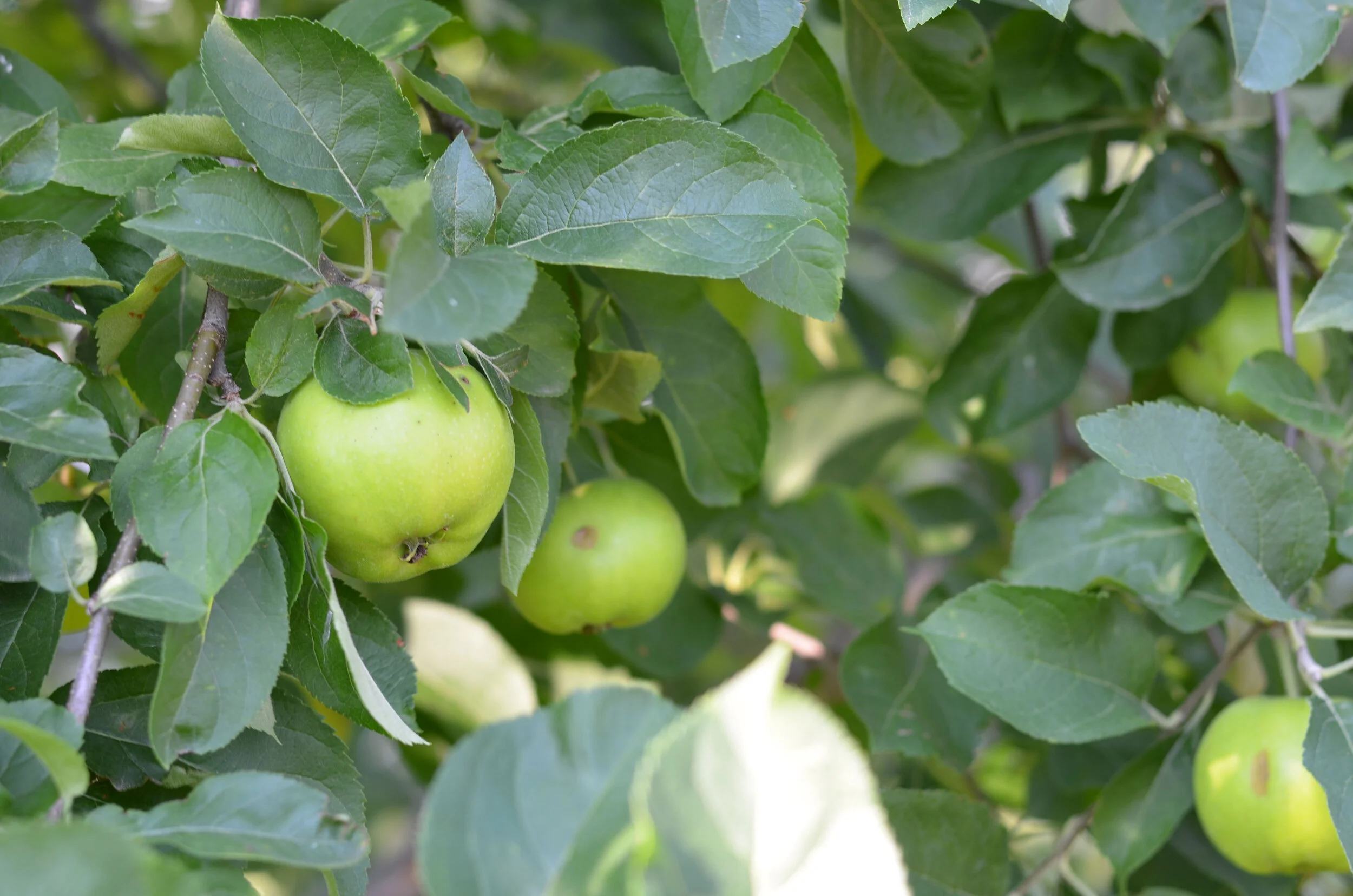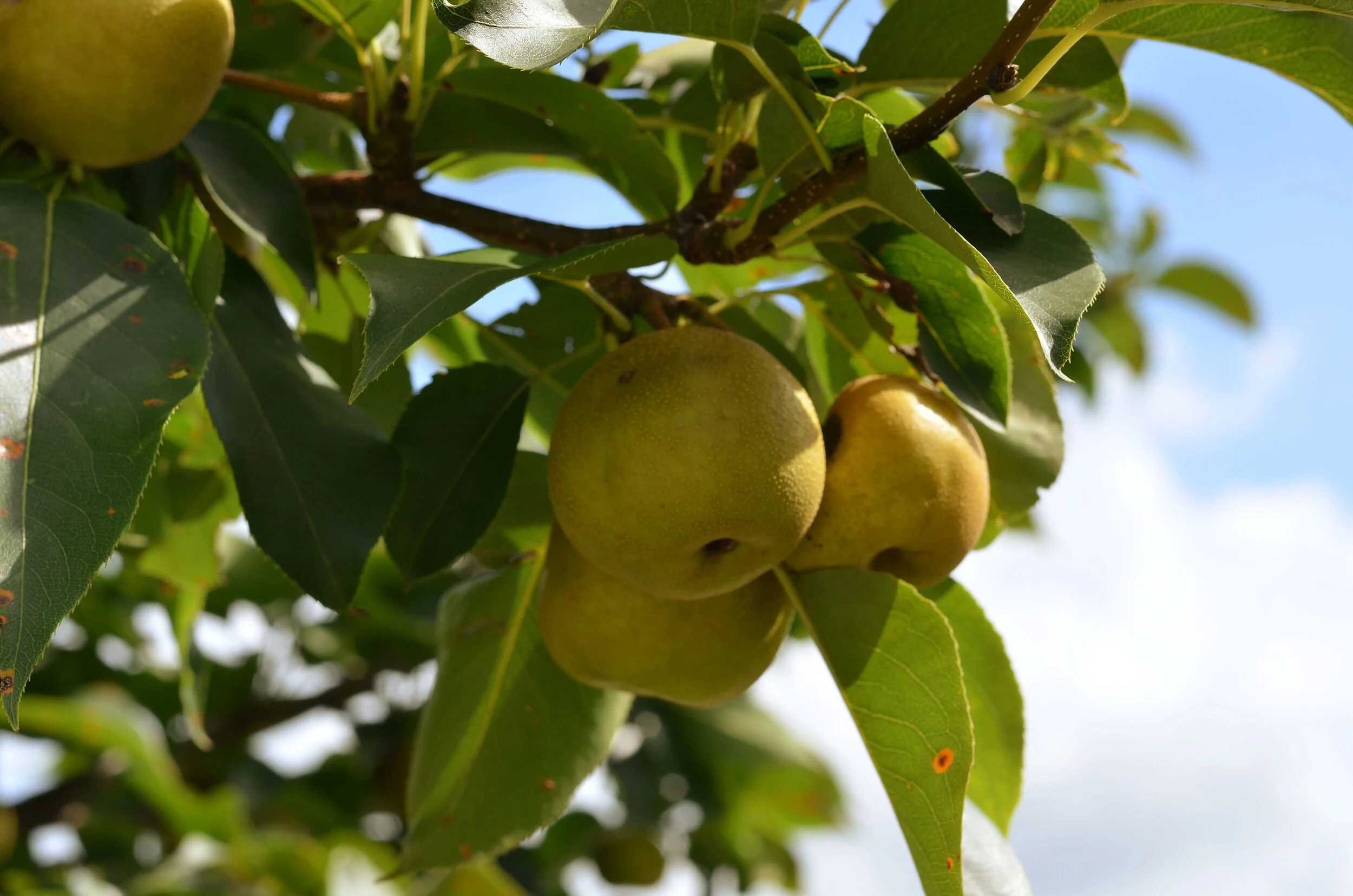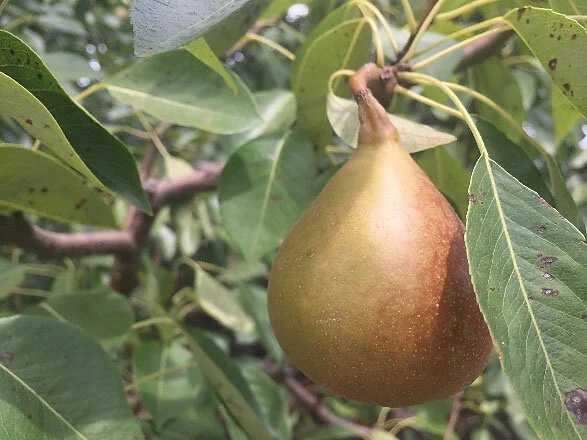Recommended cultivars are based on climate adaptability (zone 5b-8a), disease resistance (critical importance), later blooming time, storage life, nutrition, tree size, soil adaptation (rootstock), and flavor quality – with an emphasis on “Ease of Maintenance.” For information specific to your area, contact your local Giving Grove. If you would like this type of information sent straight to your inbox, consider subscribing to The Serving, The Giving Grove’s quarterly newsletter.
Recommended Conditions:
Sun Access: Full sun is preferred (8+ hours is required. Morning sun is helpful.)
Air Movement: A light wind keeps disease at bay and deters frost. Planting on a slight slope encourages air movement.
Soil: Good drainage and good soil fertility are necessary, pH between 6.5-7.0
Water: Easy access to water is encouraged.
Apple Varieties:
Selection is based on immunity to apple scab and high resistance to fireblight, cedar apple rust and powdery mildew. In most cases, you need two varieties to adequately pollinate each other unless there is a nearby crabapple tree. Trees are listed in order of ripening time.
‘Pristine’ Apple: This PRI (Purdue, Rutgers, and Illinois Universities) selection ripens early, producing large crops of yellow apples that are crisp and tasty. They are mildly tart and excellent for fresh eating, baking, or applesauce. The trees are healthy, highly resistant to apple scab and cedar apple rust, and somewhat resistant to powdery mildew and fireblight. (Needs a pollinizer/mid-late season flowering)
‘Redfree’ Apple: This PRI (Purdue, Rutgers, and Illinois Universities) selection is an attractive modern summer apple, with a high level of disease resistance. With excellent resistance to scab, it also has good resistance to fireblight and cedar apple rust. Ripens early season. (Needs a pollenizer/mid-late season flowering)
‘Williams Pride’ Apple: This PRI (Purdue, Rutgers, and Illinois Universities) selection ripens early to mid-season. Dark red apple with excellent tart fruit quality. Field immune to apple scab. Field immune to cedar apple rust; high level of resistance to fireblight; good level of resistance to powdery mildew. (Needs pollinizer/early-mid season flowering)
‘Liberty’ Apple: Liberty is very similar in appearance to McIntosh, but its flavor is a bit more tart, and its flesh is crisper. It has a wonderful flavor all its own. It is a good, dependable choice because it is highly productive, keeps well, and is resistant to all the major apple diseases. It ripens mid-season. (Needs pollinizer/early-mid season flowering)
‘Enterprise’ Apple: A glossy red apple with an excellent flavor that improves with storage. The tree is productive, vigorous, and spreading. Fruit ripens late, late season. It is an excellent choice due to its disease resistance (immune to scab and resistant to fireblight, cedar apple rust and mildew), and it stores well. (Needs pollinizer/mid to late season flowering)
‘Sundance’ Apple: A pale yellow apple with sweet sub-acid flavor and very juicy. Fruit ripens late season. Immune to apple scab, and highly resistant to fireblight and cedar apple rust with moderate resistance to powdery mildew. (Needs pollinizer/mid-season flowering)
Recommended Rootstocks G.202 10-13’ tall, M7 13-17’ tall
Cherry Varieties:
‘Carmine Jewel’ | ‘Romeo’ | ‘Juliet’ Bush Cherries: 6-7’ tall and wide. Perfect for food production and the edible landscape. The tart fruit is an early season producer. The fruits are set under the foliage so the birds don’t even know they are there! NEEDS WELL-DRAINED SOIL. (Self-fertile)
Carmine 3.5g fruit | Romeo 4.0g fruit | Juliet 5.0g fruit (all on own roots, not grafted)
‘Black Gold’ Cherry: 12-15’ tall. Late-blooming, disease-resistant sweet cherry that has a better chance of missing spring frosts. This variety is self-pollinating and fruits are large, deep red and crack resistant. Ripens early season. Needs well-drained soil. (Self-pollinating)
‘Danube’ Cherry: 10-15’ tall. A selection from Hungary, where delicious cherries have been grown for centuries. The dark red fruit has a wonderful sweet/tart unique flavor. It is a cross of the sweet and tart cherry. It is delicious eaten fresh or in baked goods. It is self-fertile, productive and ripens in the later season for cherries. (Self-pollinating)
‘Montmorency’ Cherry: 12-15’ tall. An old standard pie cherry (sour) variety with bright red skin on yellow fruit and clear juice. The Montmorency is upright, vigorous and a heavy producer. This cultivar is more productive than others and the fruit has a long ripening season. (Self-pollinating)
Asian Pear Varieties:
‘Shinsui’ Asian Pear: An early Asian Pear, ripening to a russet yellow. Trees are very precocious and require heavy thinning. Somewhat susceptible to fireblight. (Needs a pollinizer)
‘Shinseiki’ Asian Pear: Shinseiki means “New Century” in Japanese. It originates from a cross between Nijeseiki (Twentieth Century) and Chojuro. Shinseiki ripens early. The fruit is round, medium-sized, golden with white, sweet, crisp, and very juicy flesh. A good keeper. Excellent fireblight resistance. (Needs a pollinizer)
‘Chojuro’ Asian Pear: The first improved Japanese russet pear that originated in Kawasaki, Japan in 1895 by Chojuro Toma. Round shape fruits, ripening to a russet orange mid-season. Flavor once fully ripe is incredibly sweet like butterscotch with a wonderful crisp texture. Medium storage life to 4 months. (Needs a pollinizer)
‘Yoinashi’ Asian Pear: This round brown-skinned fruit is crisp, juicy and aromatic. It sets a heavy crop of medium to large fruits mid-season. Fireblight resistant. (Needs a pollinizer)
‘Shinko’ Asian Pear: Fruit is medium to large (14-20 oz.) with a brown to golden brown russet. Flesh is yellowish-white with a good juicy, sweet flavor. Fruit quality is very good to excellent. Heavy bearer. Stores 3 to 4 months. Attractive golden russet skin; firm, crisp flesh. Ripens in the later season. Fine winter keeper. Very productive. Much less susceptible to fireblight than most Asian pears. (Needs a pollinizer)
‘Korean Giant’ Asian Pear: One of the largest Asian pears sometimes weighing 1lb per or more. Ripens to russet-orange in the late season. Long storage life. (Needs a pollinizer)
Recommended Rootstock: OHxF97 (17’-19’), Betulifolia (15’ – 18’)
Pear Varieties:
‘Harrow Delight’ Pear: One of the earliest pears for harvesting. Very productive and somewhat precocious for a European pear. (Needs a pollinizer)
‘Sunrise’ Pear: Yellow pears with a slight blush. Fruit is good for eating fresh or making desserts. Also stores well, lasting 2-3 months in refrigeration. Disease-resistant to fireblight and pear scab. Introduced in 2006. Ripens early to mid-season. (Needs a polinizer)
‘Moonglow’ Pear: Medium to large, yellow fruit with a pink blush. Soft texture, sweet taste, no grit. Moonglow is a good fresh eating and canning pear that ripens mid-season. Highly resistant to fireblight. (Needs a pollinizer)
‘Moonglow’ Pear: Medium to large, yellow fruit with a pink blush. Soft texture, sweet taste, no grit. Moonglow is a good fresh eating and canning pear that ripens mid-season. Highly resistant to fireblight. (Needs a pollinizer)
‘Summercrisp’ Pear: Recognized for many years as the hardiest pear from the University of Minnesota, released in 1985. Free of fireblight. An annual bearer. Fruit is pyriform in shape, 2.5-3” in diameter and 3-3.5” long. Blooms early in May. The fruit should be harvested mid-season when crisp and still green with a red blush. Fruit harvested at that time may be stored up to 2 months. (Needs a pollinizer)
‘Blake’s Pride’ Pear: Aromatic and juicy fruit. Yellow to golden skin. Resistant to fireblight. Ripens mid-season. Excellent keeping variety. (Needs a pollinizer)
‘Potomac’ Pear: A crisp, sweet pear ripening to a light green mid-season. Excellent fireblight resistance. Two-month storage. (Needs a pollinizer)
‘Harrow Sweet’ Pear: Late season ripening. Blight-resistant release from Agriculture Canada. Ripens about 3 weeks after Bartlett; good storage till nearly Christmas, a true winter pear. Excellent flavor; sweet and juicy. Precocious and productive; usually requires heavy thinning. (Needs a pollinizer)
Recommended Rootstocks: OHxF333 (10’-12’), OHxF87 (15’-17’) and OHxF97 (17’-19’)
Peach Varieties:
‘Desiree’ Peach: Very early peach. The fruit is medium in size, highly colored, yellow-fleshed cling to semi-freestone, with excellent quality and flavor. Developed at the New Jersey Agricultural Experiment Station at Rutgers University. The tree is medium in vigor and resistant to bacterial spot. (Self-pollinating)
‘Harrow Diamond’ Peach: Very early peach. Blooms are late enough to avoid frosts and are very cold tolerant. Skin blushes red, flesh is yellow, and freestone. Resistant to bacterial spot. (Self-pollinating)
‘Redhaven’ Peach: An excellent freestone peach with red-blushed, yellow skin and firm, sweet, yellow flesh. Ideal for fresh eating, canning and freezing. (Self-pollinating)
‘Flamin’ Fury PF19-007’ Peach: ‘Flamin’ Fury’ is a series bred by peach breeder Paul Friday. It has beautiful, large (mostly 3”) highly colored, firm fruit. This tree is bacterial spot resistant, BROWN ROT RESISTANT, and a true freestone peach. Late flowering to escape frosts. Mid to late ripening. (Self-pollinating)
‘Contender’ Peach: This hardy, late-blooming peach escapes late spring frosts. Large, freestone fruit is firm, sweet, and delicious. Good for fresh use, freezing or for pies. Later ripening season. (Self-pollinating)
Bramble Varieties:
‘Natchez’ Thornless Blackberry: Large berries have excellent flavor. Plants are upright, vigorous, and hardy. The earliest blackberry! Needs well-drained soil!
‘Caroline’ Fall Bearing Red Raspberry: Starts bearing in August, and continues until a hard freeze. Very productive, and hardy with good flavor and berry size. Easy to grow and easy to prune. Needs well-drained soil!
Other Edible Landscape Recommendations:
• Persimmon– Prok, Garretson, Nikita’s Gift; (Self-fertile)
• Crandall Clove Currant (self-fertile)
• Cavendish Strawberry (self-fertile spring-bearer)
• Dwarf Mulberry– Gerardi (self-fertile)
• Gooseberry– Pixwell (self-fertile)
• Serviceberry– Autumn Brilliance (self-fertile), Success (self-fertile)
• Elderberry- Bob Gorden, York, Wyldewood; (self-fertile)
• Pawpaw– Shenandoah, Susquehanna, NC-1, Pennsylvania Gold; (needs a pollenizer)
• Hybrid Peach Almond– Reliable; (self-fertile)
• Pecan– Kanza, Colby, Pawnee, Peruque; (needs a pollenizer)
• Chestnut– Peach, Qing, Homestead; (needs a pollenizer)
• Hazelnut– Slate, Geneva, Carmella; (needs a pollenizer)
• Jujube– Li, Lang, Coco; (needs a pollenizer)
• Fig– Chicago Hardy, Peters Honey; (self-fertile)
Sources for Plant Materials:
Indiana Berry- Blackberries, Raspberries, Strawberries and other small fruits.
Nourse Berry Farm- Blackberries, Raspberries, Strawberries and other small fruits.
One Green World- Many unusual varieties and hard to find fruits.
Raintree Nursery- Many unusual varieties and hard-to-find fruits.
Stark Brothers- Apples, Pears, Asian Pears, Cherries, Peaches.
True Vine Ranch- Blueberries.
Adams County Nursery- Apples, Pears, Asian Pears, Cherries, Peaches.
Cummins Nursery- Apples, Pears, Asian Pears, Cherries, Peaches. Good source of Geneva rootstock.
Forrest Keeling Nursery- Cultivars of native fruit plants; Pawpaws, persimmons, pecans, etc.
Grandpas Orchard- Apples, Pears, Asian Pears, Cherries, Peaches.
Grimo Nut Nursery- Hazelnut, Walnut, and other nuts.
Honeyberry USA- Bush cherries, Saskatoons, small fruits.







